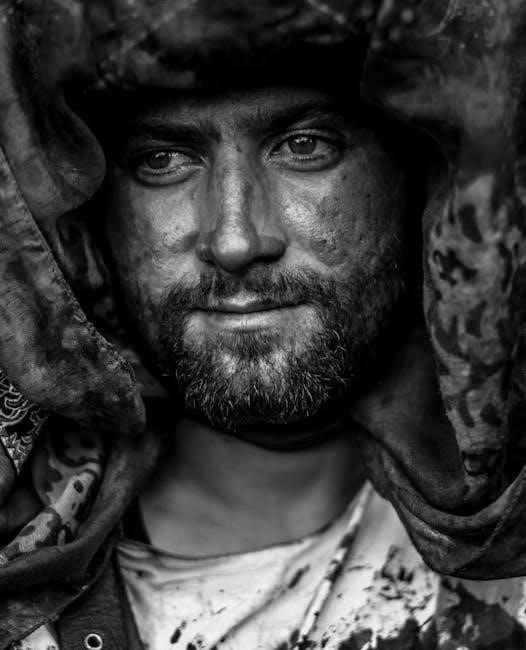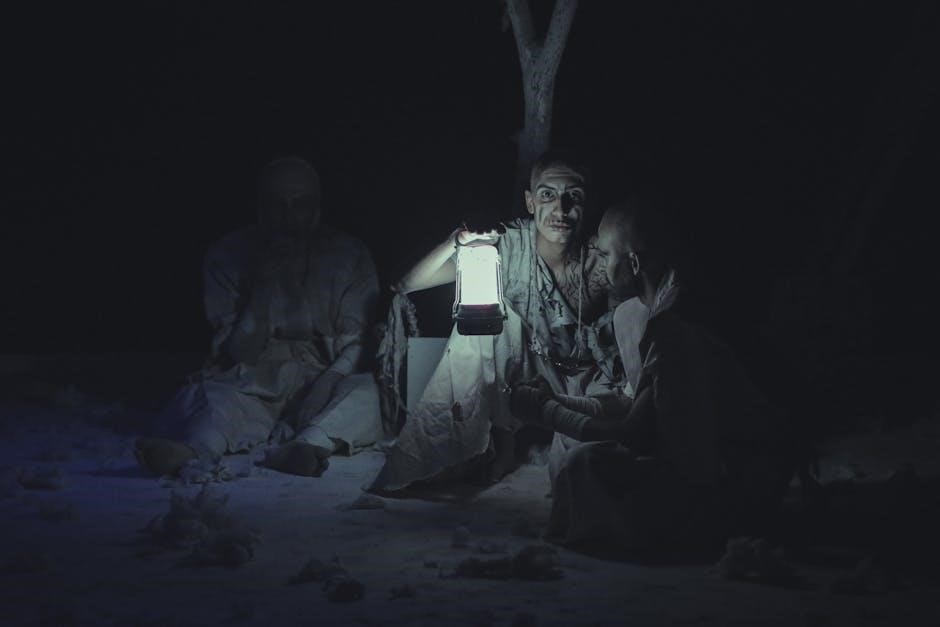Georges Bataille’s Story of the Eye is a notoriously provocative novel‚ exploring themes of eroticism and transgression․ Its controversial content has led to various digital adaptations‚ including PDF versions‚ which are widely available online despite challenges in digitizing such explicit material․
Overview of Georges Bataille and His Work
Georges Bataille was a French philosopher‚ writer‚ and literary critic known for his provocative and transgressive works․ Born in 1897‚ Bataille explored themes of eroticism‚ death‚ and the sacred‚ often challenging societal norms․ His writing blended philosophy‚ poetry‚ and fiction‚ creating a unique intellectual legacy․ Story of the Eye‚ published in 1928‚ is his most notorious work‚ blending explicit sexuality with philosophical inquiry․ Bataille’s influence extends beyond literature‚ impacting postwar French philosophy and surrealism․ His work often examines the interplay between excess‚ taboo‚ and human existence‚ making him a pivotal figure in 20th-century thought․ Despite controversy‚ Bataille remains a significant voice in exploring the boundaries of art‚ morality‚ and consciousness․

The Historical Context of the Novel

Story of the Eye‚ written by Georges Bataille in 1928‚ emerged during a period of cultural and intellectual upheaval in France․ The novel reflects the influence of surrealism‚ which was gaining prominence at the time‚ emphasizing the subconscious and the irrational․ Bataille’s work was also shaped by his interests in philosophy‚ particularly the ideas of Hegel and Nietzsche‚ as well as his fascination with the sacred and the profane․ The interwar period provided a backdrop of social and moral change‚ allowing for more experimental and transgressive literature․ Bataille’s exploration of taboo themes resonated with the era’s questioning of traditional values‚ making Story of the Eye a product of its time and a precursor to later avant-garde movements․
Why “Story of the Eye” is Significant in Literary History
Story of the Eye holds a pivotal place in literary history for its unflinching exploration of eroticism and transgression‚ challenging traditional norms of both literature and morality․ Georges Bataille’s novel is celebrated for its bold narrative style‚ blending surrealism with philosophical introspection․ It influenced later avant-garde movements and remains a cornerstone of transgressive literature; The novel’s graphic content sparked controversy‚ yet it also prompted critical discussions about the boundaries of art and the human condition․ Its enduring relevance is evident in its adaptation into various digital formats‚ including PDFs‚ ensuring its accessibility to modern readers․ Story of the Eye continues to provoke thought‚ solidifying its status as a groundbreaking work in twentieth-century literature․

Themes and Motifs in “Story of the Eye”
The novel explores eroticism‚ transgression‚ and surrealism‚ with motifs like “The Eye” symbolizing voyeurism and obsession‚ blending philosophical depth with provocative imagery․
Exploration of Eroticism and Transgression
Georges Bataille’s Story of the Eye delves into explicit eroticism and transgression‚ blending sex‚ violence‚ and surreal imagery․ The novel’s graphic content‚ including scenes of sexual experimentation and bodily fluids‚ challenges societal norms․ Through metaphors like urine and eggs‚ Bataille explores themes of taboo and excess‚ creating a visceral narrative that provokes both discomfort and fascination․ The merging of pleasure and pain reflects Bataille’s philosophical interest in the limits of human experience․ While controversial‚ the novel’s exploration of transgression serves as a critique of moral boundaries‚ offering a raw‚ unfiltered portrayal of desire and its darker dimensions․ This approach has sparked debates about the role of erotic literature in questioning cultural and ethical norms․
The Role of Surrealism in the Narrative
Georges Bataille’s Story of the Eye is deeply influenced by surrealist principles‚ blending dream-like imagery with unsettling eroticism․ The narrative’s fluid‚ fragmented structure mirrors surrealist techniques‚ creating a sense of disorientation․ Through vivid‚ often fantastical descriptions‚ Bataille explores the subconscious‚ merging sexual desire with violent imagery․ This surrealist approach allows the novel to transcend conventional storytelling‚ immersing readers in a world where reality and fantasy blur․ The PDF versions of the book preserve this surreal aesthetic‚ maintaining the text’s provocative and enigmatic quality․ By embracing surrealism‚ Bataille challenges rationality and societal norms‚ offering a narrative that is both visually striking and philosophically charged․ This blending of the bizarre and the erotic underscores the novel’s enduring impact on literary and artistic movements․

Religious and Philosophical Undertones
Beneath its erotic surface‚ Story of the Eye is rich with religious and philosophical themes․ Bataille‚ influenced by figures like Hegel and Nietzsche‚ explores ideas of sacrifice‚ transgression‚ and the sacred․ The novel’s PDF versions highlight these undertones‚ revealing a complex interplay between blasphemy and spirituality․ The characters’ actions often mirror ritualistic practices‚ blurring the lines between sin and redemption․ Bataille’s philosophy of “base materialism” is evident‚ challenging traditional notions of the divine․ The text’s digital formats ensure these profound themes remain accessible‚ inviting readers to reflect on the intersection of religion‚ philosophy‚ and human desire․ This depth transforms the novel into more than mere erotica‚ offering a philosophical journey into the heart of existence․
The Concept of “The Eye” as a Symbol
The “eye” in Bataille’s novel is a multifaceted symbol‚ representing both voyeuristic desire and transcendence․ It signifies the gaze that objectifies and consumes‚ yet also embodies insight and revelation․ The PDF versions of the text emphasize the eye’s recurring imagery‚ linking it to themes of control‚ power‚ and spiritual awakening․ The eye becomes a metaphor for the self‚ exploring boundaries between the inner and outer worlds․ Its presence throughout the narrative underscores the tension between destruction and creation‚ mirroring Bataille’s philosophical ideas on excess and taboo․ This symbolic richness invites readers to interpret the eye as both a literal and metaphorical gateway to understanding the human condition‚ making it a central element in the novel’s enduring impact․

Literary Analysis and Criticism
Georges Bataille’s Story of the Eye is a foundational text in transgressive literature‚ blending eroticism‚ surrealism‚ and philosophical inquiry․ Its controversial themes have sparked intense academic debate‚ with scholars exploring its subversion of societal norms and its influence on modern literary movements․
Critical Reception of the Novel

Georges Bataille’s Story of the Eye has garnered both acclaim and condemnation since its publication in 1928․ Critics often praise its bold exploration of eroticism‚ transgression‚ and surrealism‚ while others criticize its graphic content and perceived misogyny․ The novel’s blend of philosophical introspection and explicit sexuality has made it a focal point of academic debate․ Feminist scholars‚ in particular‚ have scrutinized its portrayal of women‚ arguing that it objectifies female bodies․ Despite these criticisms‚ the work is widely regarded as a seminal text in transgressive literature‚ influencing later writers and artists․ Its controversial nature has ensured its enduring relevance in discussions of literary provocation and cultural boundaries․ The PDF versions of the novel have further expanded its accessibility‚ sparking new waves of critical engagement․
Feminist Critiques of “Story of the Eye”
Feminist scholars have sharply criticized Story of the Eye for its depiction of women‚ arguing that the novel objectifies female bodies and perpetuates misogynistic themes․ Critics contend that Bataille’s exploration of eroticism often reduces women to mere objects of male desire‚ reinforcing patriarchal norms․ The graphic sexual content and violent imagery have been interpreted as dehumanizing‚ particularly in scenes involving female characters․ Some feminists argue that the novel’s transgressive nature overshadows its potential for meaningful critique of gender roles․ Despite these criticisms‚ the work remains a subject of academic analysis‚ with some exploring its subversive potential within feminist theory․ The availability of Story of the Eye in PDF formats has made it more accessible‚ leading to ongoing debates about its place in feminist literary scholarship․
Connection to Georges Bataille’s Other Works
Story of the Eye aligns with Georges Bataille’s broader themes of transgression‚ eroticism‚ and philosophical inquiry‚ evident in his other works like Blue of Noon and My Mother․ The novel’s exploration of excess and taboo reflects Bataille’s consistent preoccupation with pushing boundaries‚ both in literature and human experience․ Similar to his essay The Solar Anus‚ Story of the Eye employs surreal imagery to challenge conventional norms․ Bataille’s work often blurs the lines between pornography and philosophy‚ a duality present throughout his oeuvre․ The availability of Story of the Eye in PDF formats has facilitated its comparison with his other writings‚ revealing a coherent intellectual trajectory focused on transgression and the subversion of societal constraints․
Psychological and Sociological Interpretations

Story of the Eye invites profound psychological and sociological analysis‚ particularly through its exploration of transgression‚ taboo‚ and the blurring of reality and fantasy․ The novel’s graphic content and surreal imagery provoke reflections on the human psyche’s darker corners‚ such as obsession‚ desire‚ and the pursuit of extremes․ Sociologically‚ it critiques societal norms by depicting characters who reject conventional morality‚ embracing instead a world of erotic and violent excess․ The PDF versions of the book have made these themes more accessible for modern readers‚ enabling deeper exploration of how Bataille’s work challenges psychological and social boundaries․ Its controversial nature continues to spark debates about the limits of literature and its role in questioning societal structures and individual psychological complexities․

Personal and Cultural Impact

The availability of Story of the Eye in PDF has amplified its cultural impact‚ spreading its provocative themes and influencing modern literature and art‚ solidifying its notorious reputation․
Georges Bataille’s Reputation as a Provocative Writer
Georges Bataille’s reputation as a provocative writer is deeply intertwined with the controversy surrounding Story of the Eye․ The novel’s explicit exploration of eroticism‚ violence‚ and transgression shocked audiences‚ solidifying his image as a literary enfant terrible․ Bataille’s willingness to push boundaries and challenge societal norms earned him both admiration and criticism․ His work‚ particularly Story of the Eye‚ has been seen as a blend of pornography and philosophy‚ making him a polarizing figure in literary circles․ The availability of the novel in PDF format has further amplified its reach‚ ensuring Bataille’s provocative legacy endures in modern culture․
The Controversy Surrounding the Novel’s Content
Story of the Eye has long been a source of controversy due to its explicit and graphic depictions of sexuality‚ violence‚ and taboo themes․ The novel’s blending of eroticism with transgressive acts shocked readers‚ leading to widespread criticism and moral outrage․ Its content‚ including scenes involving bodily fluids and voyeuristic fantasies‚ has been deemed pornographic by some‚ while others argue it is a profound philosophical exploration․ The book’s notoriety was further amplified by its initial banning in France‚ cementing its reputation as a daring and provocative work․ Even today‚ debates persist over whether the novel crosses the line into obscenity or remains a groundbreaking work of literary art․
Influence on Modern Literature and Art
Georges Bataille’s Story of the Eye has left an indelible mark on modern literature and art․ Its exploration of surrealism‚ eroticism‚ and transgression has inspired countless writers‚ artists‚ and filmmakers․ The novel’s themes of pushing boundaries and challenging societal norms have resonated with creators seeking to explore the darker aspects of human experience․Authors like Pierre Klossowski and Maurice Blanchot have drawn inspiration from Bataille’s work‚ while visual artists have used the novel’s imagery to create provocative pieces․ Additionally‚ the book’s influence can be seen in films that blend sexuality with surreal narratives‚ further cementing its legacy as a pioneering work in both literary and artistic circles․
Adaptations and Interpretations in Film
Story of the Eye has inspired various film adaptations and artistic interpretations‚ reflecting its enduring influence․ Filmmakers like Andrew Repasky McElhinney have produced works based on the novel‚ blending its themes of sensuality and violence․ The narrative’s surreal and transgressive elements have also influenced visual artists‚ who draw inspiration from its vivid imagery․ Despite the challenges of translating such explicit content‚ the novel’s provocative nature continues to attract creators seeking to explore the boundaries of art and expression․
The “Story of the Eye” PDF
Story of the Eye is widely available in PDF format‚ with multiple digitized versions accessible online․ Its provocative content poses challenges for digital distribution platforms․
How to Create a PDF Version of the Book
Creating a PDF of Story of the Eye involves using software like Adobe Acrobat or Microsoft Word․ Convert the text into a digital document‚ ensuring formatting is preserved․ Tools like Google Docs or online converters can also be utilized for this process․ Additionally‚ existing PDFs are available for download‚ offering a convenient alternative for readers․ Ensure compliance with copyright laws when sharing or distributing the PDF․ The process is straightforward‚ allowing easy access to Bataille’s work in a digital format․
Availability of “Story of the Eye” in Digital Formats
Story of the Eye is widely available in digital formats‚ including PDF‚ e-book‚ and online versions․ Platforms like Scribd‚ Google Docs‚ and various online archives host digitized copies of the novel․ The text has been scanned and shared by multiple sources‚ ensuring easy access for readers․ Many websites offer free downloads‚ though some may require subscription or payment․ The PDF version‚ in particular‚ has been popular due to its portability and readability across devices․ Despite its controversial nature‚ the book’s digital presence remains strong‚ catering to both academic and casual readers interested in Bataille’s provocative work․ Digital formats have made this seminal text more accessible than ever‚ ensuring its enduring relevance in modern literature․
Challenges in Digitizing Controversial Content
Digitizing Story of the Eye presents unique challenges due to its graphic and controversial nature․ Many platforms restrict or remove content deemed explicit or offensive‚ limiting its availability․ Despite this‚ the novel’s PDF versions circulate widely‚ often shared through less regulated online spaces․ The book’s notoriety attracts both academic and casual readers‚ ensuring its persistence in digital formats․ However‚ the ethical and legal complexities of hosting such material pose ongoing challenges for distributors and archivists․ Balancing free access with content policies remains a significant issue in preserving Bataille’s work digitally․ Despite these hurdles‚ Story of the Eye continues to be a focal point in discussions about censorship‚ artistic freedom‚ and the role of controversial literature in the digital age․
